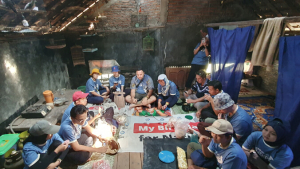
Faculty in the University of Hawaiʻi at Mānoa’s Department of Urban and Regional Planning (DURP), conducted a summer course in Indonesia designed to enable students to appreciate challenges of urbanization, climate change and resilience in the Global South. This is the third year UH Mānoa has offered a two-week immersive program in partnership with the urban and regional planning department at Diponegoro University (UNDIP) in Semarang.
“The courses offered faculty and students from both universities an opportunity to share their knowledge and creativity in responding to urban environmental problems,” said Priyam Das, an associate professor in DURP who co-designed the co-led joint course in Indonesia. “UH Mānoa students learned about resilience and informality—of settlements, services and solutions—by engaging with local communities in Semarang.”
Neighborhood visits

During the course, students attended lectures, conducted field research, and visited local neighborhoods facing unique and significant challenges. Studio-style group work enabled students to collaboratively analyze problems and propose potential solutions. They shared their findings and ideas at public presentations that concluded the program.
“Immersive and collaborative international learning experiences are essential to equip future professionals with the skills and sensitivity needed to tackle the urban challenges of a globalized world,” said Ashok Das, an associate professor in DURP, who conceived the collaborative program and led its design.
Critical learning
UH Mānoa graduate student Lahela Mattos took her first trip outside the U.S. to Indonesia. The kānaka ʻōiwi (Native Hawaiian) scholar is part of the Master of Urban and Regional Planning program at DURP. She aspires to become a professional planner and create spaces that allow Indigenous peoples to reclaim and flourish their cultural identities.
“Being able to see the effects of SLR [sea level rise] really helped me to understand what we will be facing as urban planners…we realized that planning interventions are limited for places that have already been inundated,” Mattos said.
These courses have been partly supported by the LuceSEA Transitions: Environment, Society and Change grant awarded to UH Mānoa’s Center for Southeast Asian Studies and East-West Center.
DURP is housed in the UH Mānoa College of Social Sciences.

